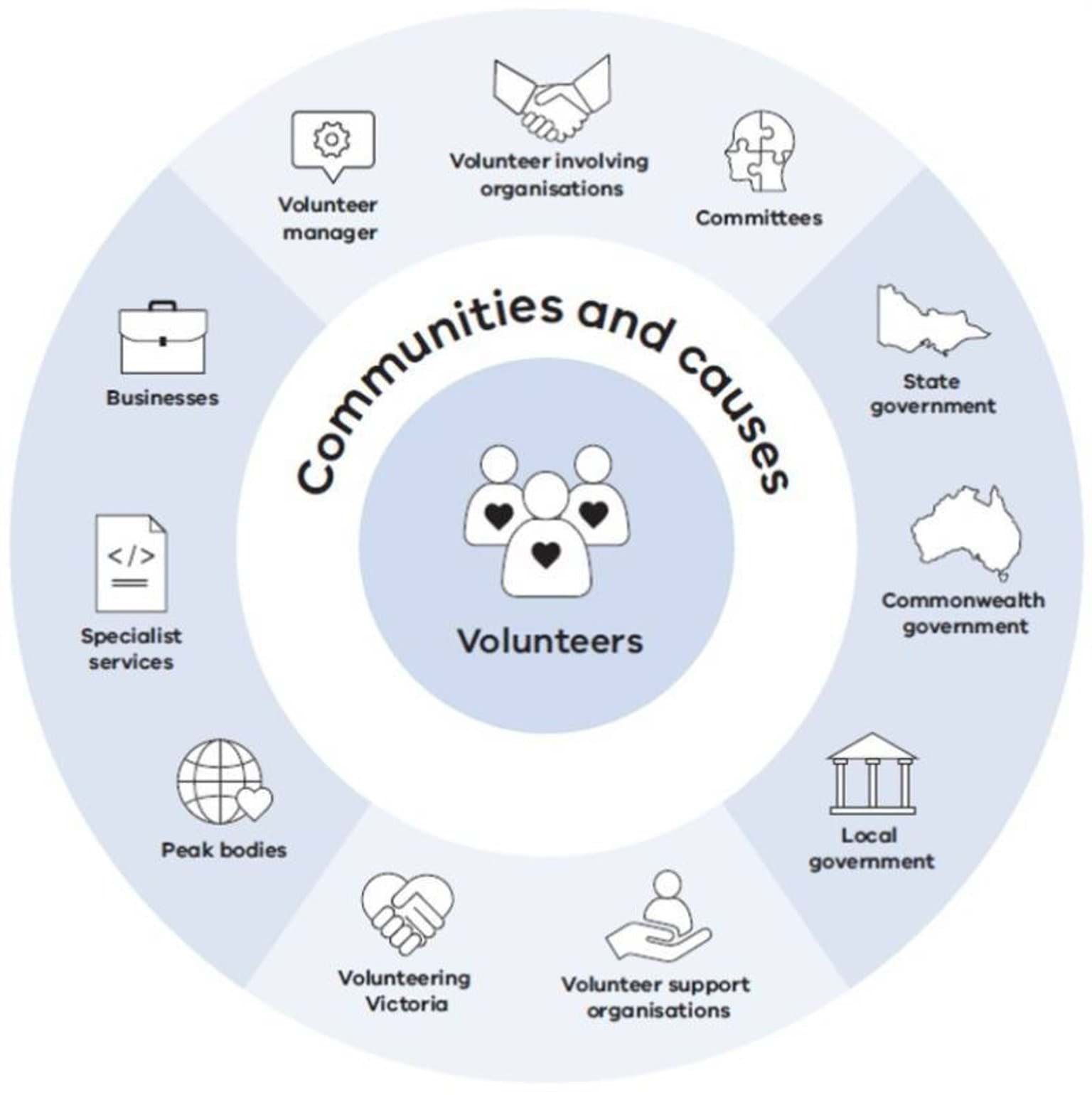Volunteering is part of Victoria’s identity. Around 2.3 million (or 42.1 per cent) of Victorians over 15 years of age volunteer formally with organisations or informally in their communities.
In 2019 the value of volunteering to Victoria was around $58.1 billion, with an average of 224 hours donated per volunteer. This equates to more than 500 million volunteer hours.1
What is volunteering?
There are many definitions of volunteering used nationally and internationally. In 2015, Volunteering Australia defined volunteering as ‘time willingly given for the common good and without financial gain’.3
In this strategy we use the term ‘volunteering’ in its most inclusive form, and will seek to recognise, support and encourage all approaches to the giving of time and expertise.
This is inclusive of ‘community-giving’ a description often assigned to volunteering by multicultural communities, as well as Aboriginal communities. Community-giving is often fluid and responsive to needs. Volunteering may be considered to be more structured, targeted and regular.
Likewise, volunteering can be divided into two categories:
- formal volunteering that takes place within organisations (including institutions and agencies)
- informal volunteering (takes place outside an organisational setting).
These distinctions are useful in a strategy like this one, which aims to enhance volunteering in organisational and non-organisational settings. Informal volunteering, particularly early in life, leads to volunteering (formally and informally) later in life.4 It is important, however, to ensure the categories don’t inadvertently mask the breadth, scope and value of the contribution and importance of all volunteering.
The definition of volunteering used in this strategy describes activities that are undertaken for the benefit of others. This could be once off, episodic or spontaneous, or structured. Examples include:
- supporting children, young people, and parents – for example reading, homework tutoring or helping with driving practice
- helping people with household activities like gardening or grocery shopping
- participating in emergency management, response and community recovery from disasters
- a range of environmental activities such as citizen science (e.g. counting birds), environmental clean-up and wildlife land care5
- contributing time and expertise every so often to community activities and events
- fundraising or advocating for a cause
- participating regularly in a structured way to support delivery of services.
Who are Victorian volunteers?
Traditionally, people volunteered because they wanted to help others and to feel a sense of belonging. One of the key drivers of volunteering is altruism. But today’s volunteers are often more interested in having new experiences or exploring new pathways in life. These are often motivated by passions and interests rather than shared needs.
Volunteer-involving organisations (VIOs) are those that provide opportunities for volunteering as part of their operation. In 2020 the top five groups of volunteers represented in VIOs were:
- over 65s (78.9 per cent)
- people with disability (31.5 per cent)
- migrants or culturally diverse people (30.2 per cent)
- under 18s (13.6 per cent)
- people from Aboriginal backgrounds (9.1 per cent).1
Victorian volunteers contribute their time and energy to support service delivery in a range of government portfolios and settings including:
- sports and recreation
- children, families and communities
- education and training
- welfare/community
- health care
- emergency management
- environmental management
- arts and culture.
These settings continue to depend on volunteers.4
Data collected in 2019 showed that within the set of Victorian volunteers surveyed:
- 5 per cent of volunteers volunteered both formally and informally
- 9 per cent of volunteers were in formal settings with VIOs (not-for-profit, government and private organisations)
- 6 per cent of volunteers donated their time only in informal settings.1
Reliable data on the numbers who volunteer in informal settings is limited. But we know that Victorians give many volunteer hours through a range of less structured channels that provide support to their communities.
The volunteering community in Victoria
The volunteering community is large and diverse. Many contributors play a variety of roles.
This strategy focuses on strengthening partnerships and collaborations within the volunteering community. This will ensure we achieve shared goals and outcomes. The strategy sets out key areas of effort and action to develop strong, collaborative and sustainable partnerships across the volunteering community (Figure 1).
Footnotes
[1] State of Volunteering 2020, State of volunteering in Victoria 2020. Retrieved from: https://stateofvolunteering.org.au/victoria/
[3] Volunteering Australia 2015, Volunteering Australia’s definition of volunteering. Retrieved from: https://www.volunteeringaustralia.org/wp-content/uploads/FAQs-Launch-of…
[4] Volunteering Australia 2021, Key volunteering statistics. Retrieved from: https://www.volunteeringaustralia.org/resources/key-facts/
[5] Victorian Government 2018, Victorians volunteering for nature: environmental volunteering plan. Retrieved from: https://www.environment.vic.gov.au/__data/assets/pdf_file/0035/394883/V…
Updated
